At the end of last summer I spent five days at Thomas Keller’s justly famed Michelin-starred restaurant The French Laundry in Napa Valley taking a special Culinary Programme (note the pretension of the continental spelling). I observed and assisted in prep, took a tour of the garden, and basically hung around trying not to get in the way for most of the day. I picked up quite a bit in terms of their operations (which doesn’t really relate to my work as a private chef) and their meticulous yet artful approach to food (which does have some bearing on my work). It was occasionally strenuous but always fun, and I loved the dedication, shared by all, to some ideal of achievable perfection. The professionalism in all layers of the organization was admirable.
The class culminated in an epic 22-course meal that left me stuffed, stunned, drunk, and reeling from sheer sensory overload. It was memorable to say the least. If you’re interested you should check out my pics and observations from that meal, which I immortalized in a post a few months back. Links are below.
My first day at the Laundry I assisted in breaking down 75 lobsters. It was an interesting technique which I’ve subsequently employed a number of times since. The gist of it is that you blanch or “steep” the lobsters in boiling water for just long enough to extract the meat from the shells. A few minutes prior to service you poach the lobster meat for a short spell in melted butter. The end result is very, very tender lobster, beautifully prepared and gorgeous to behold.
For this most recent Valentine’s Day (which I consider the phoniest of consumerist holidays) I decided to replicate this technique at home for my wife Regina. Regina is about seven months along in her pregnancy and has been downright fiendish about crustaceans. Crab, clams, shrimp, etc. The only thing she’s more insatiable about is cheap ice cream treats, but that’s another blog post for sure!
Regina is a lobster lover from birth, being a native-born Bostonian spawned with a silver (perhaps plastic) lobster fork in her hand. But the raging pregnancy hormones have intensified her primal urges and when this butter-poached lobster dish hit the table she tore into with a gusto not normally associated with “ladylike” behavior. But that’s one of the many reasons I love her — she’s just as energetically “omnivorous” as I am.
Anyway, this dish looks fancy, and in fact it does have a number of different elements going on, but don’t be intimidated. All the techniques involved are straightforward and not too challenging. I say, go for it! For your wife, husband, girlfriend, boyfriend, or anyone else you want to impress, making this dish would elicit a big “wow!” And you don’t need to wait for Valentine’s Day to come around again; make it any ole time.
The full name as it would appear on a nicely-bound menu is: butter-poached Maine lobster with wilted pea tendrils, potato puree, pan-roasted radishes, and Meyer lemon beurre blanc. In this post I’ll go over the steps for preparing the lobster and give you a basic recipe for lemon beurre blanc. Wilted pea tendrils can be subbed with quickly sauteed spinach or mustard greens. The potato puree is a very creamy, refined mashed potato; below I’ve provided a link to my simple mashed potato recipe. Whip in a little extra cream to that recipe and you’re golden.
I posted a recipe for pan-roasted radishes a few days ago, so you can try that simple tip if you like. Baby turnips work as a substitute, and roasted baby beets are an excellent choice as well. You’ll notice from the pictures that I drizzled a little green-hued oil on the plate as a garnish. That’s scallion oil and it’s super-easy to make. I plan on posting a short recipe for that in the next day or so.
To steep the lobsters you need to start with two lobsters (one for you and one for your lover) weighing in at between 1.5 and 2 pounds each. You’ll need two pots — one to put your lobsters in and one to boil the water in. Put your lobsters in one and put enough water to fully cover the lobsters in the other. The pot (or any big container large enough to accomodate your victims) with the lobsters should go on the countertop near the sink, the pot with the water on the stove. Be sure to roughly measure your water as you’ll need to add about a 1/2 cup of white vinegar for each 8 quarts of water you boil. I also like to throw in the water a couple of lemons, sliced.
Turn the heat up to high and cover with a lid. While waiting for the water to boil be sure to snip off the rubber bands holding the lobster claws. I use a pair of kitchen scissors to cut them off and then pull them out of the pot with a pair of tongs. Don’t get your fingers near the claws!
When the water boils set up an ice bath to immediately cool your lobster after it’s cooked; this can be as simple as a big bowl with lots of ice water in it. Also, you’ll need to put on some heavy-duty rubber gloves to break down the lobster so put these within reach. You need a kitchen timer as well; I use my phone, but of course an old crank-timer will work. Set the timer to three minutes.
When the water comes to a rolling boil pour it quickly over the lobsters. Start the timer and put on the gloves. When three minutes have elapsed pull the lobsters from the water with some long tongs. Grasping a lobster by the head in one hand and the tail in the other, twist firmly to separate the two sections. Drop the tails in the ice bath. Now, twist off the two “arms”, the sections containing the claws and the “knuckles” of the lobster. Separate the knuckles and put into the ice bath with the tails. Return the claws to the boiling water. Set timer for five minutes. After the arms have steeped for five minutes, place them in the ice bath to cool.
You can discard the bodies or use them to make lobster stock. Or you could roast them in the oven and eat the innards — there’s some good eating in there, althoughth it’s not for the faint of heart as the viscera can appear a bit grisly: but the tomalley (the soft, pale-greenish stuff) is excellent, as well as any roe. In fact, if you see anything that’s blackish-green and sort of tubular, you should save it and poach in the butter along with meat. That’s the sweet, dense lobster roe. The flavor is mild, slightly briny, and dipped in a little butter it’s delicious.
Now that you’ve par-cooked the lobster you need to remove the meat from the shells.
Do the tails first by grasping the thin, stiff back flipper and snapping it upwards toward the smooth back of the lobster tail. It should break off cleanly, revealing the slender tips of the lobster tail. There are two ways to remove the meat. You can either carefully snip the shell off of the meat with a pair of kitchen shears, or you can forcefully push the lobster meat through the entirety of the shell with your forefinger by applying pressure through the hole you just made in the very end. The first method is easier but more laborious. The second method takes practice, but once you get the idea it’s much, much faster. Novices should probably try the first method.
To remove the digestive “vein” of the lobster you can either cut a slit along the top of the tail meat and carefully remove the vein, or you can try removing the vein with the use of a pair of large tweezers or a small bamboo skewer. The tail is segmented, as you can probably tell. You can puncture little holes between the segments and root around inside the meat of the tail to find the vein. Pull out carefully with tweezers or use a skewer to hook underneath the vein to pull it free. The vein is also evident at the meaty “front” of the tail, as well as underneath the back flipper. You might have to delve in several areas of each tail to make sure you’ve removed all of the vein, as it is fragile and can break easily. This second method can be a pain in the ass, but you’ll have a lovely lobster tail, uncut along the back and mostly unmarred. During the removal of the vein, if you notice a chunk of blackish-greenish lobster roe, you should save it and cook it and eat it.
To remove the meat from the knuckles you can either crack them open with the back of a heavy knife (or a crustacean hammer) or use kitchen scissors to cut off the shell. Try to pry the meat out cleanly if you can.
To remove the meat from the claw first wiggle the small pincer side to side and snap it off. Using the back of a heavy knife crack the claw shell in the thickest part. You don’t want to smash the shell and the meat inside, just crack it enough to free the claw meat; so try to regulate your force when you try to crack it. At The French Laundry once the shell is cracked and the bottom part of the claw shell is torn free, the claw is held by the tip and the meat is flicked downward and released with a quick movement. I found this to be a great technique for breaking down large quantities of lobster, but it takes a little practice. I recommend cracking the claws enough so you can gently pry out the meat in one nice piece with your fingers.
If you want, you can trim off the claw tips and discard them, leaving just the “mitt” of the claw, the palm of the claw, if you will. Although I’m not a big fan of the claw tips (they can be tasteless and rubbery), Regina loves them so I left them on for this recipe.
At The French Laundry the lobster meat is poached in buerre monté, which is a butter emulsion, meaning that the butterfat and the milk solids are bound together and don’t separate as long you keep the liquid under approximately 190° F. I don’t bother with this level of refinement at home. I think you can just poach the meat in plain melted butter and get fantastic results.
Of course it takes a ridiculous amount of butter. I melted over low heat two pounds of butter — one salted, one unsalted — in a small pot. I used a candy thermometer to keep the butter under 200° F. I poached the tails for about four minutes and then added the claws. I poached the meat another eight minutes and then added the knuckles, which were already fully cooked so I just had to warm them for one minute. I turned off the heat on the butter and then assembled the plate.
I quickly sauteed the pea tendrils in a little olive oil with a tiny bit of minced shallots. The beurre blanc was warm on the stove. The potato puree was finished. The roasted radishes were warm.
So I mounded a little pile of potatoes in the center of a warm plate and I placed a little pile of the wilted pea tendrils adjacent to it. I put half a lobster tail on the potatoes and added a little lobster knuckle meat around it. I topped the tail with a beautiful lobster claw, which I brushed with a little more melted butter. I sprinkled a tiny bit of fleur de sel over the lobster. I drizzled a little meyer lemon beurre blanc around the lobster and dolloped a bit of the green scallion oil over the beurre blanc. I scattered a few roasted radishes on the plate. I added that tiny baton of butter-poached lobster roe to the plate. And that was the dish! It was superb!
____________
Meyer Lemon Beurre Blanc
You need:
- 1/3 cup lemon juice, Meyer lemons preferred
- 1 tablespoon finely minced shallots
- a pinch of sugar
- 1 stick cold unsalted butter, cut into small cubes about a 1/2 inch in diameter
- about 1/4 teaspoon kosher salt or fluer de sel
- a pinch of white pepper
I had a little leftover lobster meat, beurre blanc, and scallion oil. For another course that night I put some of that lobster meat on a plate with the two sauces and topped it with a little bit of crispy pancetta. I barely had any appetite left by that point, but my wifey scarfed it down with relish, declaring it delish!
A tip: you’ll have lots of leftover butter lightly infused with lobster flavor, most of which you can’t use for anything else. I did manage to recycle a bit and make an amazing lobster scramble for my breakfast the next morning, utilizing a bit of that fantastic butter.
Related posts:
Roasting radishes: https://spencerhgray.wordpress.com/2012/02/15/pan-roasted-radishes/
Mashed potatoes: https://spencerhgray.wordpress.com/2011/11/01/mashed-potatoes-the-potato-chronicles-pt-11/
The French Laundry dinner: https://spencerhgray.wordpress.com/2011/08/22/the-french-laundry/
The French Laundry garden: https://spencerhgray.wordpress.com/2011/08/25/the-french-laundry-un-tres-beau-jardin/
My copycat French Laundry dinner: https://spencerhgray.wordpress.com/2011/08/20/my-laundromat/
My copycat French Laundry dinner menu: https://spencerhgray.wordpress.com/2011/08/21/my-laundromat-the-menu/
Another look at lobster: https://spencerhgray.wordpress.com/2011/05/02/big-ass-lobster-part-two-the-demise-of-felix/
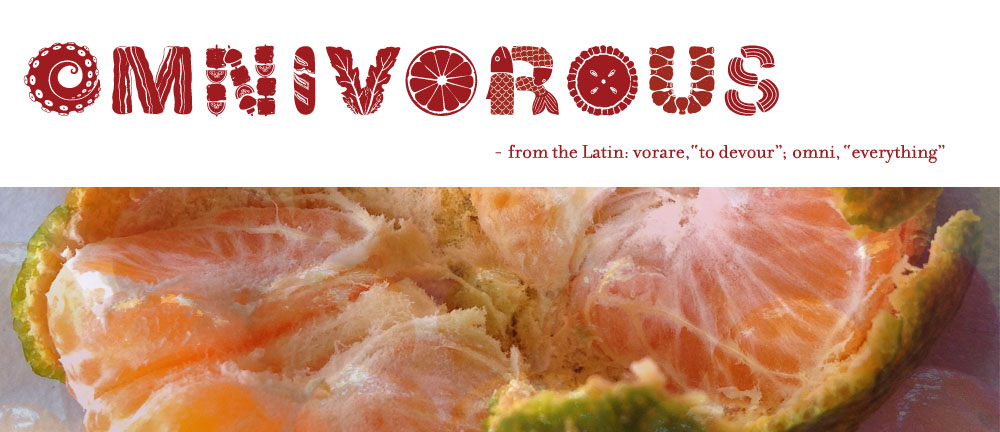
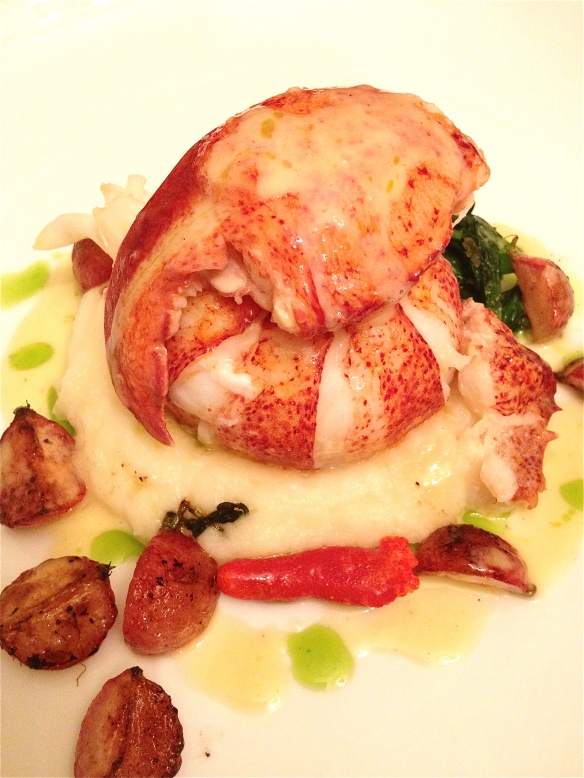
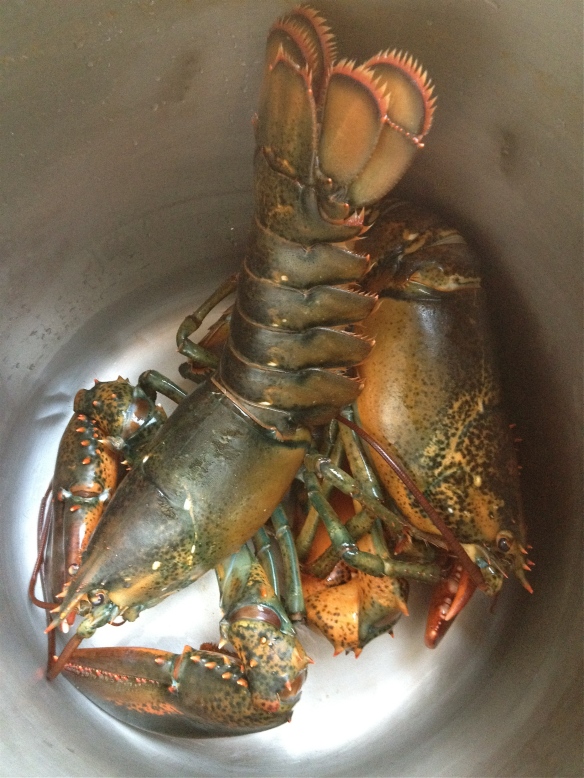
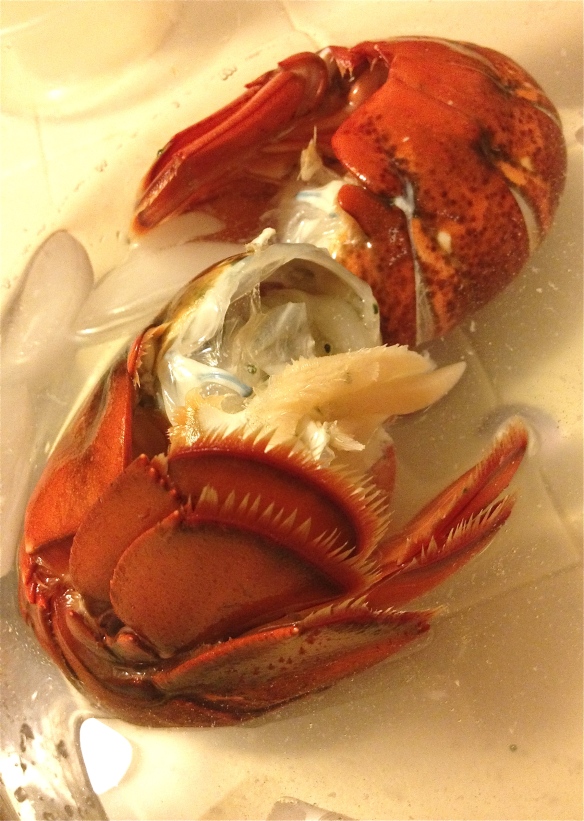
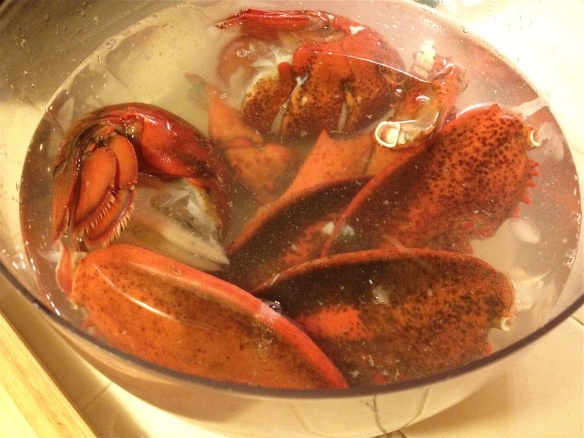
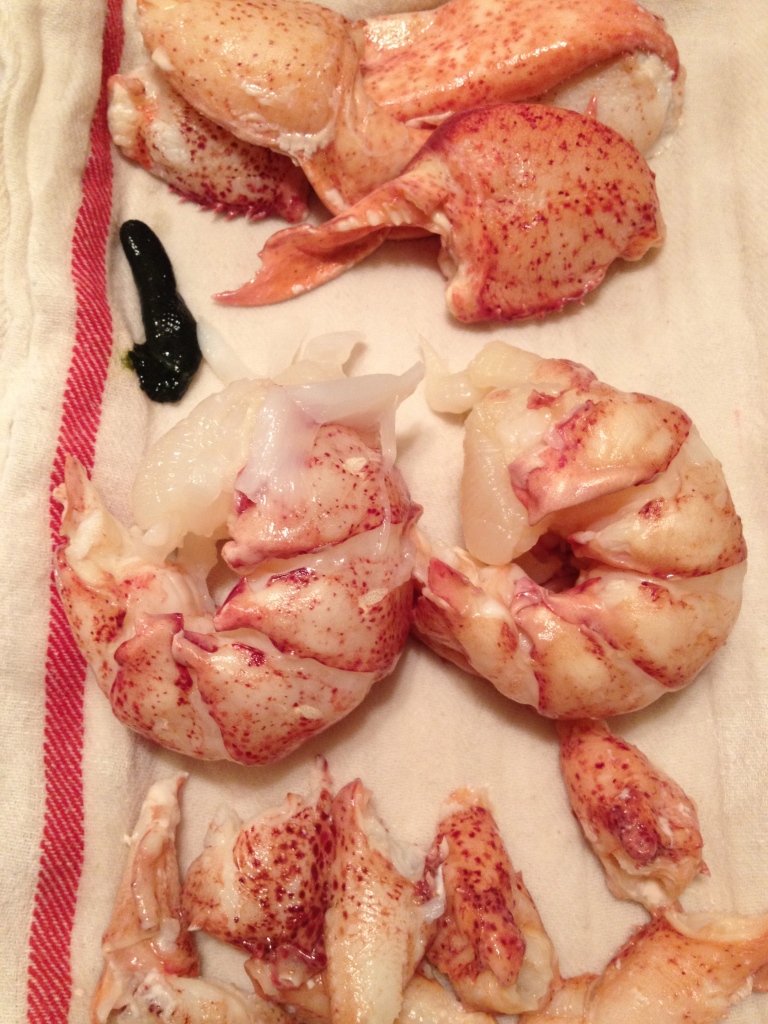
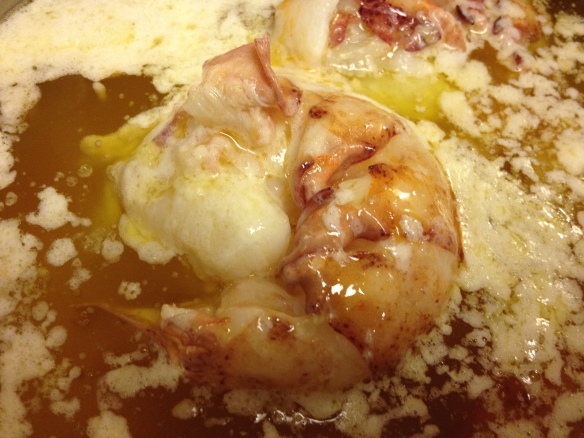
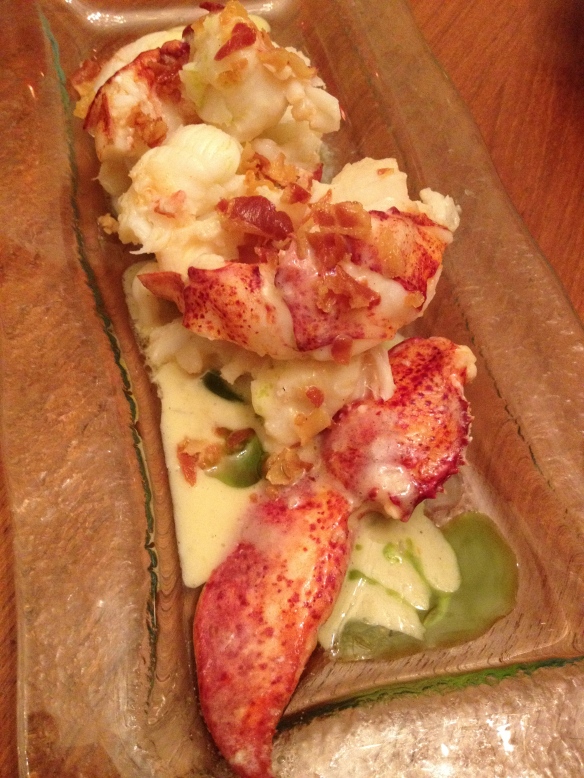
This lobster looks delicious 🙂
Yum! And I love the idea of a Meyer Lemon Beurre Blanc sauce!
We make a lobster dinner every year for our sons birthday, this is his request every since he was a child and now is 37. We try lobster different ways each year this by far is our favorite, we will be making it again this weekend. Thank you for the recipe.
I have never ever seen blackish green roe in all the millions of lobsters I’ve eaten, only redish orange roe, but I’m trying this recipe tomorrow!
I admit that the only part of this awesome presentation is the butter poached lobster, but I’ve made it 5 times so far for special friends and have found it to be uncomplicated and absolutely succulent!! I’ll be making a New Years eve surf and turf for 4 this year ( rib eye steak and 6 oz butter poached lobster tails) and my guests are SO thrilled to taste my “tails”. Word has spread! I can’t recommend this method more highly; if you’re hesitant, go on and give it a try – you’ll be a rock star!
Woops! I meant to post “I admit that the only part of this awesome presentation I’VE MADE…